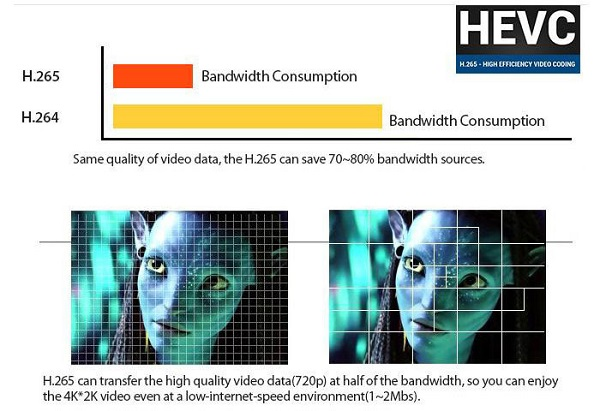Video compression technology is crucial for the efficient transmission and storage of video content, which is essential in today’s digital age. As video content becomes increasingly prevalent across various platforms, from streaming services to social media, the demand for effective compression solutions continues to grow. Advances in video compression technologies have led to significant improvements in quality, efficiency, and accessibility. This essay explores the evolution of video compression technologies, recent advancements, and their impact on the media industry and user experience.

The Evolution of Video Compression
Early Compression Techniques
Video compression began with basic techniques aimed at reducing the amount of data required to represent video content.
- Discrete Cosine Transform (DCT): Introduced in the 1980s, DCT was a fundamental technique in early video compression standards. It transformed video frames into frequency components, allowing for the removal of redundant information.
- Motion Compensation: Motion compensation, used in standards like MPEG-1, helped reduce the amount of data by predicting motion between consecutive frames. This technique played a crucial role in improving compression efficiency.
MPEG Standards
The Moving Picture Experts Group (MPEG) developed several standards that significantly advanced video compression.
- MPEG-1: Released in 1993, MPEG-1 introduced the concept of compressing video and audio together. It was widely used for video CDs and early digital video applications.
- MPEG-2: Released in 1995, MPEG-2 improved compression efficiency and supported higher resolutions and bit rates. It became the standard for DVDs and digital television broadcasting.
- MPEG-4: Introduced in 1998, MPEG-4 offered enhanced compression capabilities and supported a range of media types, including video, audio, and text. It included features like object-based coding and scalability.
Recent Advances in Video Compression Technologies

HEVC (High Efficiency Video Coding)
HEVC, also known as H.265, is a significant advancement in video compression technology.
- Improved Compression Efficiency: HEVC offers approximately 50% better compression efficiency compared to its predecessor, H.264 (AVC). This means that HEVC can deliver the same video quality at half the bit rate, making it ideal for high-definition and ultra-high-definition content.
- Advanced Coding Tools: HEVC incorporates several advanced coding tools, such as larger block sizes, improved motion estimation, and enhanced in-loop filtering. These tools contribute to its superior compression performance.
- Applications: HEVC is widely used in streaming services, broadcast television, and video conferencing. Its efficiency makes it suitable for handling the increasing demand for high-resolution content.
AV1 (AOMedia Video 1)
AV1, developed by the Alliance for Open Media, represents a new generation of video compression technology.
- Open and Royalty-Free: AV1 is designed as an open, royalty-free codec, which makes it accessible to a wide range of users and reduces licensing costs. This is in contrast to some other codecs that involve licensing fees.
- High Compression Efficiency: AV1 achieves compression efficiency comparable to or better than HEVC while supporting high dynamic range (HDR) and wide color gamut (WCG) content. This makes it suitable for modern video applications and emerging technologies.
- Support and Adoption: AV1 is supported by major technology companies and is increasingly being adopted for streaming, video conferencing, and other applications. It is designed to be compatible with a wide range of devices and platforms.
VVC (Versatile Video Coding)
VVC, also known as H.266, is the latest standard in video compression technology.
- Enhanced Compression Efficiency: VVC offers substantial improvements in compression efficiency over HEVC, achieving up to 50% better compression for the same video quality. This advancement is crucial for handling ultra-high-definition and 8K content.
- Versatility and Flexibility: VVC is designed to support a wide range of applications, including immersive media (such as virtual reality and augmented reality), high dynamic range content, and adaptive streaming.
- Industry Adoption: While still in the early stages of adoption, VVC is expected to play a significant role in the future of video compression, particularly as demand for high-resolution and immersive content grows.
Impact on the Media Industry

Streaming Services
Advancements in video compression technology have a profound impact on streaming services.
- Bandwidth Optimization: Improved compression algorithms allow streaming services to deliver high-quality video content while reducing bandwidth consumption. This is crucial for delivering content to users with varying internet speeds and data limits.
- Content Quality: Enhanced compression techniques enable streaming platforms to offer higher resolution and better-quality video, including 4K and HDR content. This enhances the viewer experience and meets the growing demand for high-definition media.
- Cost Efficiency: Efficient compression reduces the cost of storing and transmitting video content. This cost-saving benefit is significant for streaming services that handle large volumes of content and serve millions of users.
Video Conferencing
Video compression advancements also impact video conferencing applications.
- Reduced Latency: Improved compression algorithms reduce latency and improve the quality of video calls. This is essential for maintaining smooth and clear communication in real-time.
- Enhanced Visual Quality: Better compression techniques contribute to clearer and more detailed video, which is important for professional and personal video conferencing applications.
- Scalability: Efficient compression enables video conferencing platforms to support a larger number of participants and higher resolution video, enhancing the versatility and scalability of these services.
Broadcast and Digital Media
The advancements in video compression technologies benefit traditional broadcast and digital media.
- High Definition and Ultra High Definition: Compression improvements enable broadcasters to deliver high-definition (HD) and ultra-high-definition (UHD) content more efficiently. This is important for meeting viewer expectations and providing a premium viewing experience.
- Content Delivery Networks (CDNs): Efficient compression supports the effective distribution of content through CDNs, ensuring that video is delivered quickly and reliably to users across different locations.
Challenges and Considerations
Computational Complexity
Advances in video compression often come with increased computational complexity.
- Processing Power: Modern compression algorithms, such as HEVC and VVC, require more processing power for encoding and decoding. This can pose challenges for devices with limited computational resources.
- Hardware Support: Ensuring that hardware devices and software platforms support the latest compression standards is crucial for widespread adoption. This may involve upgrading hardware or software to accommodate new codecs.
Compatibility and Interoperability
Compatibility and interoperability issues can arise with new compression standards.
- Device and Platform Support: New codecs may not be supported by all devices and platforms, leading to compatibility issues. Ensuring that content is accessible across different devices and platforms requires careful consideration.
- Software Updates: Keeping software and systems updated to support new compression standards is essential for maintaining compatibility and delivering high-quality content.
Licensing and Patents
Licensing and patent issues can impact the adoption of video compression technologies.
- Royalty-Free Codecs: The push for open and royalty-free codecs, such as AV1, aims to address concerns related to licensing fees and patent issues. This promotes wider adoption and reduces costs for content creators and distributors.
- Patent Licensing: For codecs that involve licensing fees, managing patent licenses and ensuring compliance with licensing agreements is important for avoiding legal issues and ensuring fair use.

Future Trends in Video Compression
AI and Machine Learning
Artificial intelligence (AI) and machine learning are expected to play a significant role in the future of video compression.
- Adaptive Compression: AI algorithms can optimize video compression in real-time based on content characteristics and network conditions. This adaptive approach improves compression efficiency and video quality.
- Content-Aware Compression: Machine learning techniques can enhance compression by focusing on important content areas and reducing data for less critical parts of the video. This results in better quality and reduced file sizes.
8K and Beyond
The demand for 8K and higher resolution content is driving advancements in video compression technology.
- Efficient Handling of 8K Content: Advanced compression algorithms are needed to efficiently handle 8K video content, which requires significantly more data than lower resolutions. This is essential for supporting the growing adoption of 8K displays and content.
- Future-Proofing: Developing compression standards that can accommodate future resolutions and formats ensures that video technologies remain relevant and effective as display technology evolves.
Conclusion
Advances in video compression technologies have significantly impacted the media industry, enabling more efficient storage, transmission, and delivery of video content. From the early days of discrete cosine transform and motion compensation to the latest developments in HEVC, AV1, and VVC, the evolution of video compression has been marked by continuous improvements in efficiency and quality. These advancements benefit streaming services, video conferencing, and broadcast media by optimizing bandwidth, enhancing content quality, and reducing costs.
While challenges such as computational complexity, compatibility, and licensing remain, ongoing innovations in AI, machine learning, and higher resolution content are shaping the future of video compression. As technology continues to advance, video compression will play a crucial role in meeting the growing demands of a global audience and delivering high-quality, accessible media experiences.
For more such content, keep visiting QAWire


